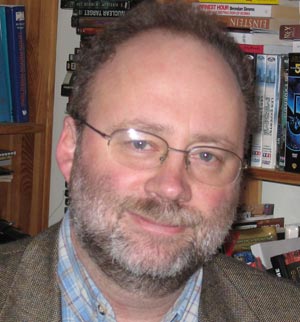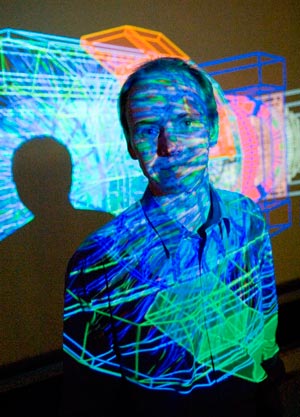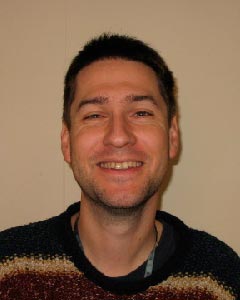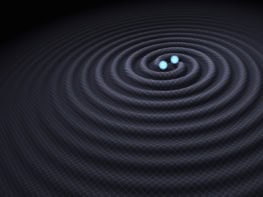The Large Hadron Collider at CERN has recently achieved record-breaking collisions at 7 TeV, marking the start of its physics programme. James Dacey goes to CERN to catch up with scientists from the four experiments at the LHC. In a series of quick-fire interviews, he finds out some of their hopes and aspirations for the coming months.
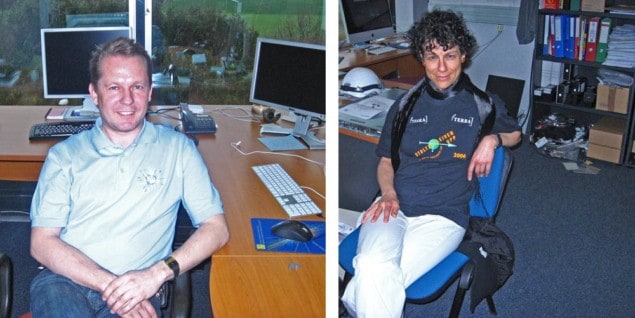
ATLAS: Hanspeter Beck and Anna Lipniacka
• Hanspeter Beck, deputy leader, Bern ATLAS group
• Anna Lipniacka, deputy co-ordinator of ATLAS, Norway
With both ATLAS and CMS are searching for the Higgs how much rivalry is there?
AL: [laughs] Yes, there is a healthy competition between the two of us, a bit like an Olympic Games of CERN. No, but seriously, it is very necessary because we are the only people on Earth who have an accelerator like this. If we only had one detector it would have a complete monopoly on seeing the result and if we were wrong there would be no-one to check us.
What do we know so far about the Higgs?
HB: We know from LEP [the Large Electron Positron collider, the predecessor of the LHC] that its mass should lie between 115 and 160 GeV, and could even be as heavy as 200 GeV. If it does not exist in this mass range, then we know that it does not exist at all. In itself this would be an extremely interesting discovery because we would have to go over our textbooks and look for other mechanisms for how particles get their mass.
But do you have any idea where it might lie within this range, and will that affect the difficulty of the search?
HB: From previous findings at the Tevatron [at Fermilab in the US] and theoretical studies, is seems most probable that the Higgs mass is a tick above 115 GeV. And if it is there, it will be ultra difficult and will take up to 6 years to prove or disprove if it exists.
If it is around 160 GeV then that is different. In 18 months from now we will be able to say if we have found it. But who knows where it is.
Is there anything else you hope to see in your experiment?
AL: My personal dream is that the LHC will become a dark-matter factory.
HB: This substance does not interact with light and is supposed to make up one-quarter of the mass in the universe.
AL: We can study dark matter on the galactic scale and make a map of dark matter, but we don’t know the exact local structures. We suspect that dark matter interacts weakly, and from this we can judge probability of particles interacting with one another. There is a possibility that we are now getting enough energy now to produce them.
The LHC has received a lot of attention over the past few years, in part because of the sheer scale of the project. Do you think this interest will be maintained as the scientific results emerge?
HB: Good research will always create an impact back to society. It changes the way we look back on ourselves. This goes back to Galileo when he said the Earth is not the centre of the universe.
AL: This is not only physics. We are going to a new land with new instruments. We have never ever seen matter in such extreme conditions and we are bound to learn new things.
CMS: Albert de Roeck
• Albert de Roeck, deputy spokesperson, Compact Muon Spectrometer (CMS)
Do you have any sort of timetable for results?
By autumn it is going to get quite interesting here and, particularly by winter, when the accelerator is going to stop for one or two months, we will be frantically looking to the data. We will have our first pop at the Higgs at the end of the year. We will certainly exclude mass regions, but discovery is much more difficult.
But supersymmetry could well be there by the end of the year. “Sparticles” [supersymmetric particles that are partners of every normal particle] would be of the order 500 Gev, and we are kinematically getting to this region. If the luminosity of the LHC beams lives up to promises, we are going to bypass the Tevatron in the region search for supersymmetric particles – definitely by end of 2011.
If you still can’t find the Higgs after running the LHC at full power (14 TeV) for two years, as planned, can you say that it doesn’t exist?
We can certainly say by then that the Standard Model Higgs does not exist.
It will make people uneasy because most people think there will be a sort of Standard Model type of Higgs. But there are more exotic models out there where the Higgs can be mimicked, or not seen, or have negative interferences at much smaller cross sections.
However, I should say that many of these non-Standard Models should show up within the capabilities of this machine. So people will be more inclined to think that the Higgs does not exist, and there is something else going on there.
The four LHC experiments seem to function very separately: why is this?
We have what we call a friendly competition.
For example, they will not talk to each other if they start to see something. Though there is sort of a gentleman’s agreement between the experiments that when things get out, the other experiments get sort of a warning. And that is not on a level that they can start the analysis and finish at that level but at least they are not taken completely by surprise when they go into a public meeting and say we have that discovery.
It’s just like a politeness thing – for the benefit of science and a good healthy collaboration. For example, when we had the first paper out [Feb 2010], we gave a week’s notice.
ALICE: David Evans
• David Evans is a physicist at the University of Birmingham who leads the UK team on the ALICE experiment
How have things been going and what are your hopes for this year?
We are taking a lot of data and we are expecting to see a lot of new physics, especially when the LHC starts circulating lead particles towards the end of the year. Only by colliding lead ions will we recreate a quark–gluon plasma, the exotic primordial soup that would have existed up to ten-millionths of a second after the Big Bang.
After the start of the physics programme went so well, we are hoping that 2010 will be the year that Christmas comes twice.
What kind of physics are you hoping to discover at ALICE?
Among the fascinating things that may emerge is a more thorough understanding of the strong interaction – the least well known of the four fundamental forces.
Up to 98% of particle mass is accounted for by this strong force, but we still don’t really understand why quarks get confined in groups. At ALICE we will get as close as you can to studying free quarks.
To make an analogy, we are in a similar position to the pioneers of electromagnetism in the 19th century. Now, in the 21st century, we are studying another fundamental force: the strong force.
Do you think it was a good decision to run the LHC at half power for 18 months?
I think it will be an advantage to raise the energy of collisions in steps. If we went straight to 14 TeV then, if we saw any exciting new phenomena, we would need to check those results at a lower energy anyway, to see when this new physics kicks in.
LHCb: Niko Neufeld
• Niko Neufeld, deputy leader of the online system project in the LHCb collaboration
LHCb is smaller than the other detectors. What is it looking for?
We have a specialized machine for the study of CP violation, a phenomenon responsible for the difference between matter and antimatter.
There is a fundamental asymmetry in a small part of the Standard Model. It is a violation in the decay properties that makes antimatter decay just that little bit faster and that is why all the antimatter has gone – there are no anti-Suns, no antimatter galaxies…
How long do you think it will take before you can start drawing any conclusions?
The way the machine is going right now, I think we can really start serious physics within a few months’ time – when the accelerator gives us a few hundred thousand “beauty hadrons” per second. Then towards the end of this year we should be in full swing and hopefully have the first draft papers for the winter conferences of next year.
How do you find working at CERN?
For me, the international aspect is one of the best things. Before, it was a sort of European club, which was already cool, but now, with the LHC, CERN has become a truly international laboratory. It is very enriching; you learn about different science cultures. It is very interesting to find that even within the same field physics can be taught in a range of manners.
